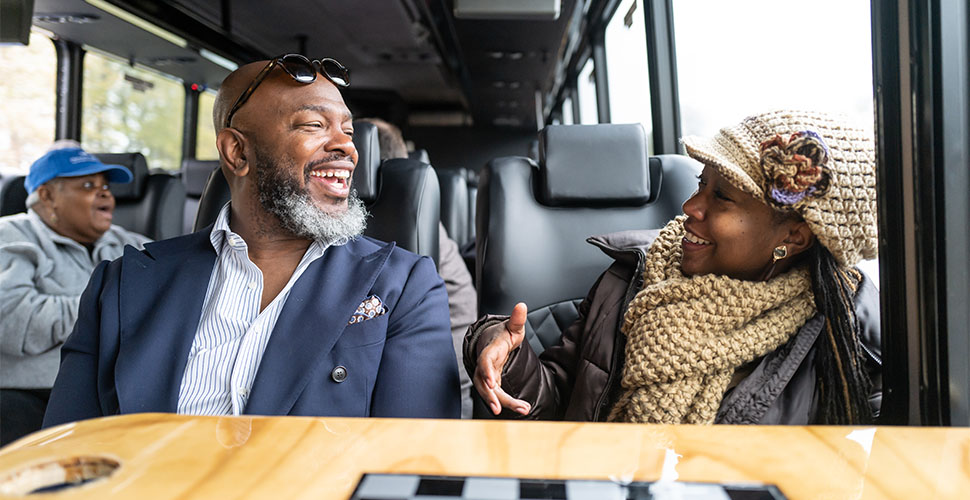A current look into Wake Forest’s past
Slavery, Race and Memory project funds student trip
During a November bus trip to Wake Forest University’s original campus outside Raleigh, School of Divinity Professor Derek Hicks took 21 students to a nondescript cemetery where many of the tombstones had carvings but no names. He wanted his African American Religious Experience class to visit the cemetery because of its ties to a chapel where enslaved people who helped build the original campus once worshipped.
On the ride to the town of Wake Forest, Hicks’ students interacted with local poet Jacinta White, who recently published a book titled “Resurrecting the Bones: Born from a Journey through African American Churches & Cemeteries in the Rural South.” White couldn’t prepare them for how they would feel at the cemetery but encouraged them to channel their emotions into a class assignment to write a poem about the experience.

Over the past few years, Wake Forest has been committed to acknowledging and understanding the role slavery played in its past. In 2016, Wake began taking a deep dive into its history, and in 2017 it joined Universities Studying Slavery (USS), a consortium of colleges and universities that are examining the role slavery played on their campuses. Out of that work came the Slavery, Race and Memory project, which funded the trip.
“The trip Professor Hicks’ class took is an example of the type of enriching opportunities we want our students to have, opportunities to engage with the past and make the linkages to the present day.” Kami Chavis, associate provost for academic initiatives and co-chair of the Slavery, Race and Memory project Steering Committee
“We hope other professors will take advantage of these grant opportunities to enrich their classes,” said Chavis.
Lovelle McMichael, a first-year Master of Divinity student, said his emotions ranged from sadness to anger to reverence during the outing.
“On the bus ride over, I wondered why we were going to visit the graves of these unknown people,” said McMichael, a Philadelphia native. “But when I got there, I almost felt like our ancestors were appreciative that they weren’t forgotten.”
Hicks, associate professor of religion and culture in the Wake Forest School of Divinity, learned about the cemetery from Sarah Soleim, who joined the staff of the Wake Forest Historical Museum in June to help preserve and share the history of Wake Forest.
“You get in there and you’re transported into another world.” Derek Hicks, associate professor of religion and culture in the School of Divinity
“It’s a sacred space with a swell in the ground, understood to be a mass grave, and an open space believed to be a hush harbor where formerly enslaved people worshipped. It was just a powerful experience,” said Hicks.
It seemed as though the cemetery trees ushered in the Wake Forest contingent that day, said Mary Tribble, associate vice president who leads the alumni engagement office, which oversees the Historical Museum on the original campus.
“The visit to the cemetery felt like a pilgrimage …” she said. “On the ride back to campus there was a lot of thoughtful discussion about the experience but also about the history that led to it. The trip was a good use of Slavery, Race and Memory project funds and a great way to go from theory to practice, to bridge that gap.”
Hicks said he wanted his students to get a sense of the experiences of peoples of African descent, and their faith. While in the town of Wake Forest that day, students met with members of Friendship Chapel Baptist Church and Olive Branch Baptist Church, both of which have ties to the original campus.
“In the class we consider ways in which religious faith becomes a cultural toolkit, through which African Americans found solace and a voice to create a language for their longings and desires to be considered full citizens…” Hicks said. “We ended the day with lunch and a panel discussion with people who want to ensure this history we’re studying now stays vibrant in that community. Wake Forest College was inextricably tied to that community – among white and black people – until it moved to Winston-Salem in 1956.”
The significance of the trip wasn’t lost on McMichael or the other students.
“It was interesting to learn more about Wake Forest’s history,” McMichael said.
“I’m glad Wake Forest had the courage to acknowledge its past and is taking steps toward making the campus inclusive. If the University can do that, I’ll definitely be proud to be part of this legacy.” Lovelle McMichael, first-year Master of Divinity student
Categories: Community in Progress, Faculty, School of Divinity, Student, Top Stories

